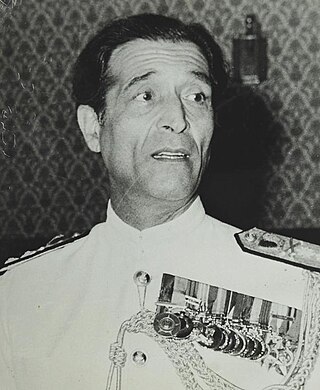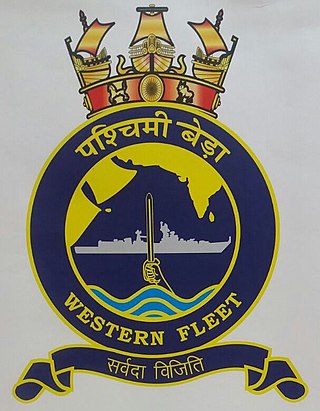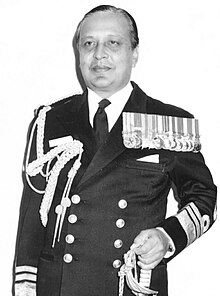
Admiral Arun Prakash, PVSM, AVSM, VrC, VSM is a former Flag Officer of the Indian Navy. He served as the Chief of the Naval Staff from 31 July 2004 to 31 October 2006 and as the Chairman of the Chiefs of Staff Committee from 31 January 2005 to 31 October 2006. He is one of India's most decorated naval officers.

The Western Naval Command is one of the three command–level formations of the Indian Navy. It is headquartered in Mumbai, Maharashtra. As the senior–most of the three formations, the command is responsible for the all naval forces in the Arabian Sea and western parts of the Indian Ocean and the naval establishments on the west coast of India.

The Eastern Naval Command is one of the three command-level formations of the Indian Navy. It is headquartered in Visakhapatnam, Andhra Pradesh. The command is responsible for the all naval forces in the Bay of Bengal and parts of the Indian Ocean and the naval establishments on the east coast of India.

Admiral Adhar Kumar Chatterji was an Admiral in the Indian Navy. He served as the 6th Chief of the Naval Staff, from 4 March 1966, until 28 February 1970. He was the first Indian officer of the navy to hold the rank of full Admiral. He is credited with the transformation of the Indian Navy. He made sweeping changes and restructured the navy, creating the Western and Eastern Naval Commands and the Western Fleet. Under him, the Indian Navy also entered the submarine age, with the commissioning of INS Kalvari (S23) in 1967.

Admiral Radhakrishna Hariram Tahiliani, PVSM, AVSM was a Flag officer in the Indian Navy. He served as the 12th Chief of the Naval Staff from 1 December 1984 until 30 November 1987. His prior commands included those as the Flag Officer Commanding-in-Chief (FOC-IN-C) of the Western Naval Command, FOC-IN-C of the Southern Naval Command and Flag Officer Commanding Western Fleet (FOCWF). A carrier-based aircraft pilot, he also served as the commanding officer of the aircraft carrier, INS Vikrant.
Admiral Jal Cursetji, PVSM was a former Flag Officer in the Indian Navy. He served as the ninth Chief of the Naval Staff (CNS) from 1 March 1976 until 28 February 1979. He was the first hydrographer to serve as the CNS.

Vice Admiral Rustom Khushro Shapur 'Rusi' Ghandhi, PVSM, VrC was a former flag officer in the Indian Navy. He last served as the Flag Officer Commanding-in-Chief Western Naval Command from 1977 to 1979. He is the only officer to have commanded ships in all wars and conflicts post Independence. He commanded the frigate INS Betwa (1959) during the Annexation of Goa, the destroyer INS Khukri (F149) during the Indo-Pakistani War of 1965 and the cruiser INS Mysore (C60) during the Indo-Pakistani War of 1971.

The Western Fleet is a Naval fleet of the Indian Navy. It is known as the 'Sword Arm' of the Indian Navy. It is headquartered at Mumbai, Maharashtra on the west coast of India. It is a part of the Western Naval Command and is responsible for the naval forces in the Arabian Sea and parts of the Indian Ocean.

The Eastern Fleet is a Naval fleet of the Indian Navy. It is known as the 'Sword Arm' of the Eastern Naval Command and called the Sunrise Fleet. It is headquartered at Visakhapatnam, Andhra Pradesh on the east coast of India. It is a part of the Eastern Naval Command and is responsible for the naval forces in the Bay of Bengal and parts of the Indian Ocean.

Flag Officer Commanding Western Fleet (FOCWF) is the title of the Indian Navy Officer who commands the Western Fleet, headquartered in Mumbai, Maharashtra. The FOCWF is a two star admiral holding the rank of Rear Admiral. The appointment is considered to be an important and a coveted one. The Current FOCWF is Rear Admiral Vineet McCarty, who assumed office on 15 November 2022.

Vice Admiral Sree Harilal Sarma, PVSM was an Indian Navy admiral who served as Flag Officer Commanding Eastern Fleet (FOCEF) during the Indo-Pakistani War of 1971. He later served as the Flag Officer Commanding-in-Chief Eastern Naval Command from 1 March 1977 to 2 February 1978.

Flag Officer Commanding Eastern Fleet (FOCEF) is the title of the Indian Navy Officer who commands the Eastern Fleet, headquartered in Visakhapatnam, Andhra Pradesh. The FOCEF is a Two Star Officer holding the rank of Rear Admiral. The Current FOCEF is Rear Admiral Gurcharan Singh, who assumed office on 30 November 2022.

Vice Admiral Swaraj Parkash, PVSM, MVC, AVSM was a Flag officer in the Indian Navy. He was the Captain of the aircraft carrier INS Vikrant during the Indo-Pakistani War of 1971 for which he was decorated with India's second-highest military decoration, the Maha Vir Chakra. He later served as the second Director General of the Indian Coast Guard from 1980 to 1982.

Vice Admiral Vasudeva Anant Kamath, PVSM (1921–2017) was a former Flag officer in the Indian Navy. He was the founding Director General of the Indian Coast Guard, which he led from 1978 to 1980. He also served as the 4th Vice Chief of the Naval Staff (VCNS) from 1973 to 1977, the longest tenure in the Indian Navy's history. During the Indo-Pakistani War of 1971, he led the Southern Naval Area, for which he was awarded the Param Vishisht Seva Medal.
Vice Admiral Elenjikal Chandy Kuruvila, PVSM, AVSM was a former Flag officer in the Indian Navy. He was the Fleet commander of the Western Fleet during the Indo-Pakistani War of 1971, for which he was awarded the Param Vishisht Seva Medal. He later led the Southern Naval Area and then served as the Chairman and Managing Director of Mazagon Dock Limited.

Rear Admiral Pritam Singh 'Peter' Mahindroo, PVSM (1917-1999) was a Flag Officer in the Indian Navy. He was the first Sikh Admiral in the Indian Navy. He was the commissioning Commanding Officer of the Indian Navy's first aircraft carrier INS Vikrant. He later served as the Chief of Materiel and as the Director General Naval Dockyard Expansion Scheme before retiring in 1972.

Vice Admiral Melville Raymond Schunker, PVSM, AVSM was a flag officer in the Indian Navy. He served as the third Director General of the Indian Coast Guard, which he led from 1982 to 1984. He also served as the 6th Vice Chief of the Naval Staff (VCNS) from 1980 to 1982. He was the commissioning commanding officer of the Indian Navy's only submarine tender ship INS Amba (A54).
Vice Admiral Kankipati Appala Satyanarayana Zagapathi 'KASZ' Raju, PVSM, AVSM, NM is a former Flag officer in the Indian Navy. He last served as the Flag Officer Commanding-in-Chief Western Naval Command, from 1992 to 1994. A naval aviator, he was part of the Navy's first naval air squadron INAS 300 and was embarked on the Navy's first aircraft carrier INS Vikrant. During the Indo-Pakistani War of 1971, he was the executive officer of the Leopard-class frigate INS Brahmaputra (1957), for which he was awarded the Nao Sena Medal. He later commanded the Western Fleet and the Southern Naval Command.
Rear Admiral Sadashiv Ganesh Karmarkar, MBE was a flag officer in the Indian Navy. He was the first Indian officer to command a ship of the Royal Indian Navy. During World War II, he commanded the auxiliary patrol vessel HMIS Ratnagiri, for which he was awarded the Member of the Order of the British Empire (MBE). He later became the first Indian to command British officers, when he commanded the sloop HMIS Kistna. He last served as the Flag Officer Bombay, from 1960 to 1964, before retiring.
Rear Admiral Arun Auditto, AVSM, NM was a Flag Officer in the Indian Navy. He was decorated with a gallantry award during the Liberation of Goa. A pioneer submariner in the Indian Navy, he was the commissioning Commanding Officer of the Kalvari-class submarine INS Kursura (S20), which he commanded during the Indo-Pakistani War of 1971. He later commanded the submarine base INS Virbahu and the Whitby-class frigate INS Trishul (F143). After promotion to flag rank, he served as the Fortress Commander Andaman and Nicobar (FORTAN) and as the first Flag Officer Submarines, before retiring in 1988.














